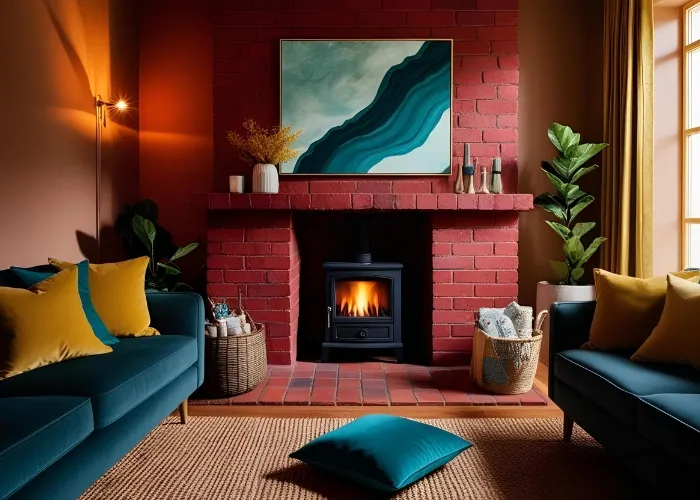Charming Kids Study Room Ideas to Inspire Daily Learning

A cluttered, distracting, or poorly designed study area can quickly turn homework into a battle and dampen a child’s enthusiasm for learning. Without a dedicated, organized space, children struggle with focus, materials get lost, and productivity suffers. The key is to create an environment that supports concentration, fosters independence, and makes learning an inviting activity.
This article offers practical solutions to transform any corner into an effective study zone, addressing common issues like distractions and disorganization. We’re covering 12 imaginative kids’ study room ideas, featuring everything from space-saving setups to design elements that promote calm and creativity.
These selections emphasize ergonomic comfort, effective organization, and a stimulating yet distraction-free atmosphere, proving that a study area can be both practical and inspiring.
Principles for Effective Kids’ Study Zones
- Minimizing Distractions: The study area should be free from excessive visual clutter, noise, and tempting toys. It’s like a quiet zone where focus can thrive. A calm environment supports better concentration.
- Ergonomic Comfort: A chair and desk sized appropriately for the child’s height prevent discomfort and promote good posture. It’s like a tailored fit where physical well-being matters. Proper ergonomics support longer study sessions.
- Ample Storage: Dedicated spots for books, stationery, and supplies keep the workspace tidy and functional. It’s like a well-organized toolkit where everything is accessible. Effective storage reduces time spent searching for items.
- Good Lighting is Essential: Adequate natural and artificial light prevents eye strain and maintains alertness. It’s like a well-lit stage where clarity is crucial. Proper illumination supports visual tasks and reduces fatigue.
12 Kids Study Room Ideas
Discover innovative ways to create organized, stimulating, and distraction-free study spaces for children.
1. Dedicated Desk Nook
Carve out a specific corner or wall recess for a desk, utilizing the existing architecture to create a naturally defined study zone. This helps psychologically separate the learning area from the rest of the room. It’s like a small office where focus is the primary goal.
Ensure the desk is sized appropriately for the child’s age and that there’s enough space for a comfortable chair. Add wall-mounted shelves or a pegboard above the desk for essential storage.
2. Under-Loft Bed Workspace
Maximize vertical space by positioning a desk and chair underneath a loft bed, effectively creating a private study area without taking up additional floor space. This is an excellent solution for smaller rooms, blending sleep and study zones seamlessly. It’s like a compact workstation where every dimension is utilized.
Choose a sturdy loft bed with ample headroom for comfortable sitting. Integrated shelving or drawers can further enhance the functionality of this clever setup.
3. Closet Conversion Study Zone
Transform an unused or lightly used closet into a quiet and secluded study nook by removing the doors and installing a built-in desk and shelves. This creates an inherently private space, ideal for minimizing distractions. It’s like a hidden library where concentration can flourish.
Add task lighting, comfortable seating, and personalized decor to make the space inviting. This option offers a perfect blend of isolation and accessibility.
4. Wall-Mounted Fold-Down Desk
Install a desk that folds up against the wall when not in use, offering a practical workspace that disappears to free up floor space for play. This is perfect for very small rooms or multi-functional spaces. It’s like a flexible workbench where space adapts to need.
Ensure the desk is sturdy and easy for a child to operate safely. Pair it with wall-mounted storage to keep supplies accessible even when the desk is closed.
5. Shared Double Desk Setup
For siblings sharing a room, implement a long desk that accommodates two workstations side-by-side, providing each child with their own dedicated study space. This fosters individual responsibility while promoting a shared learning environment. It’s like a collaborative office where personal boundaries are respected.
Ensure each section has its own lighting and storage. Consider a divider or separate cubbies to help maintain individual organization and minimize distractions between the two.
6. Window-Facing Desk
Position a desk directly in front of a window to maximize natural light and offer a pleasant view, which can be calming for some children. This provides a bright and airy workspace that reduces reliance on artificial lighting during the day. It’s like a bright observatory where learning is illuminated.
Ensure the view isn’t overly distracting for your child; if it is, consider sheer curtains to filter light while maintaining brightness. Natural light is crucial for eye comfort and mood.
7. Pegboard Organization Wall
Install a large pegboard above the study desk to create a flexible and customizable storage system for stationery, notes, and small supplies. This keeps essentials visible and within reach, reducing clutter on the desk surface. It’s like a modular display board where tools are always organized.
Pegboards are versatile; hooks, shelves, and small baskets can be rearranged as organizational needs change. This encourages children to personalize their storage solutions.
8. Mobile Study Cart
Utilize a multi-tiered rolling utility cart equipped with stationery, notebooks, and small reference books, allowing the study materials to be moved to any quiet spot. This offers flexibility for children who prefer to study in different locations. It’s like a portable learning station where knowledge travels with them.
Choose a sturdy cart with smooth-rolling wheels and locking casters for stability. This is particularly useful in homes without a dedicated study room, allowing any table to become a temporary desk.
9. Integrated Desk with Bookcase
Select a desk unit that seamlessly integrates with a bookcase or shelving system, providing extensive storage for books and study materials directly adjacent to the workspace. This creates a cohesive and highly functional learning hub. It’s like a complete academic unit where everything has its place.
Ensure the bookcase elements are at an accessible height for the child. This design makes it easy to transition from reading to writing or other study tasks.
10. Minimalist Study Zone
Design a study area with only essential items: a simple desk, comfortable chair, and a single task light, keeping distractions to an absolute minimum. This uncluttered approach promotes focus and reduces visual noise. It’s like a focused retreat where simplicity reigns supreme.
Choose clean lines and neutral colors for furniture to enhance the calm atmosphere. This style is especially effective for children who are easily overstimulated.
11. Ergonomic and Adjustable Furniture
Invest in a desk and chair that are height-adjustable, allowing them to grow with your child and maintain ergonomic comfort throughout different stages of development. This ensures proper posture and reduces strain during long study sessions. It’s like a custom fit where adaptability is key.
Proper ergonomics are vital for preventing back and neck pain. An adjustable setup also means the furniture remains suitable for many years, offering good value.
12. Command Center Wall
Design a wall adjacent to the study desk with a combination of a cork board, magnetic board, and perhaps a small whiteboard. This creates a centralized area for schedules, important notes, and inspirational messages. It’s like a mission control where organization is visualized.
This helps children keep track of assignments, deadlines, and personal goals. Encourage them to personalize it with their own drawings or motivational quotes.
Cultivating a Positive Learning Environment
- Personalize with Inspiration: Allow your child to add personal touches like a favorite drawing, a small plant, or motivational quotes. This makes the space feel inviting and their own. It’s like a personal studio where creativity is encouraged.
- Maintain Cleanliness: Regularly declutter the study area with your child, returning items to their designated spots. This teaches responsibility and keeps the workspace effective. It’s like a tidy workshop where efficiency is valued.
- Establish a Routine: Encourage consistent use of the study space at set times each day. This builds a habit of focused work and associates the area with learning. It’s like a regular practice where consistency yields results.
Frequently Asked Questions About Kids’ Study Rooms
What is the ideal size for a kids’ study desk?
The ideal size for a kids’ study desk depends on the child’s age and the available room space. For young children, a desk about 24-30 inches wide might suffice. Older children and teenagers will benefit from a wider desk, around 40-50 inches, to accommodate books, a computer, and space for spreading out materials.
Crucially, the desk height should allow their feet to be flat on the floor (or supported by a footrest) and their elbows to rest comfortably at desk level when sitting.
How do I light a kids’ study area effectively?
Effectively lighting a kids’ study area involves both ambient (general room) lighting and specific task lighting. Position a good quality desk lamp that provides direct, glare-free light on the workspace. For right-handed children, place the lamp on their left; for left-handed, on their right, to avoid shadows.
Natural light is beneficial, so placing the desk near a window is ideal, but ensure curtains or blinds are available to control glare. Supplement with overhead lighting to avoid stark contrasts.
How can I make a study room interesting for a child who resists homework?
To make a study room interesting for a child who resists homework, involve them in designing the space, choosing colors or accessories. Incorporate elements of their interests without creating distractions, like a subtle theme.
Ensure the space is comfortable, well-organized, and clutter-free, making it feel less daunting. Use a reward system for completed tasks to build positive associations with the study area.
Should a study room be completely separate from the bedroom?
While a separate study room is ideal for minimizing distractions, it’s not always practical. If combined, use visual cues like a rug, different wall color, or a screen to define the study zone from the sleeping area.
The goal is psychological separation: when in the study zone, the child knows it’s time to focus, and when in the rest of the bedroom, it’s time for relaxation or play.
What are good storage solutions for study materials?
Good storage solutions for study materials include wall-mounted shelves, cubbies with labeled bins, desk drawers, and pegboards. Vertical organizers for files and notebooks, and small containers for pens, pencils, and art supplies keep the desk tidy.
Consider rolling carts for mobile storage or integrating shelving directly into the desk unit for a cohesive look. Clear containers can also help children quickly see where items belong.
Nurturing a Foundation for Future Success
Creating an inspiring and functional study room for your child is an investment in their academic journey and personal growth. By meticulously designing a space that promotes focus, encourages organization, and minimizes distractions, you empower them to take ownership of their learning. Thoughtful choices in furniture, lighting, and storage transform a mere room into a dynamic hub for curiosity and accomplishment.
Begin by understanding your child’s individual learning style and needs, then select ideas that build a supportive and inviting environment. Remember, a well-crafted study space is more than just a place for homework; it’s where their intellectual adventures truly begin.
Which study room idea will you implement to inspire your young learner? Share your favorite concepts below!






